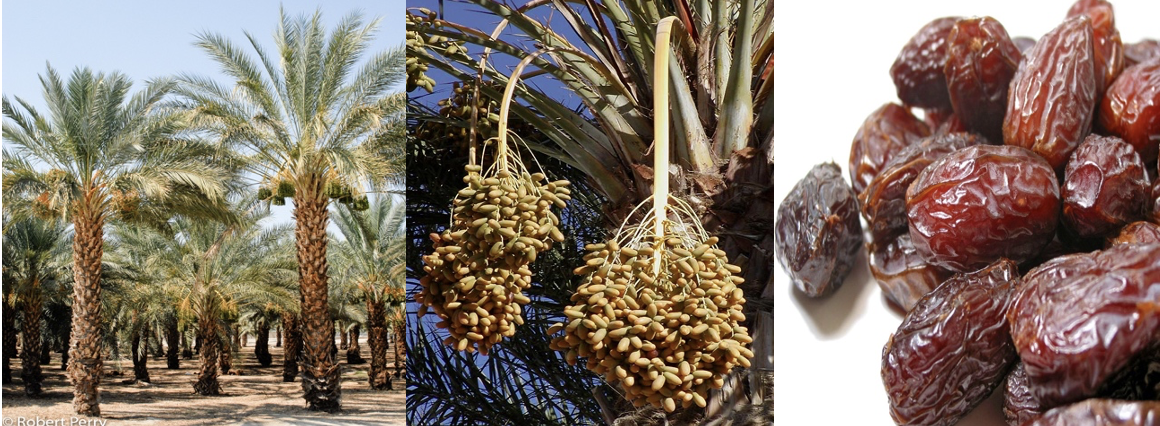🌴 Date Palm
Important points, varities, pests

- Botanical Name:
Phoenix dactylifera - Family: Arecaceae
- Origin: West Asia
- Date contains 75 - 80% carbohydrates in form of invert sugars.
- One kg fully ripe fresh dates provide approximately 3150 calories.
- Single seeded berry.
- Inflorescence is known as
spadix. - In India-Date is harvested at Doka stage.
- In other countries date is harvested at Dang stage.
- Fruits for fresh eating are preferred at Dang stage.
- Date harvested at doka stage have 70-80% moisture.
- Doka fruits are successfully processed to prepare chhuhara.
- Drink of Date palm is known as
Dibbis. - Liquor prepared from date palm is
Arrack, popular in Iraq.

- Developmental stage of Date
- Hababouk
- Gandora or chirmi: Fully grown, Hard, yellow in colour
- Dang or Rutab: Softening
- Pind or Tamer: Fully ripe and dehydrated
- It is said that,
Its feet in running water and its head in the fire of the sky.
- A fine date variety requires 3300 units of heat for full maturity.
- 10% male should be raised in orchard to provide adequate pollen grains.
- Time of leaf pruning:
June - Ethephon is an effective fruit thinning agent.
Metaxeniais common in Date palm.- Exploitation of metaxenia – to induce earliness & improvement in quality.
- Trailer mounted palm duster is used for pollination.
- Date juice suitable varieties: Zagloul, Hayani.
- Khadrawy and Medjool developed by somatic embryogenesis.
Varieties
- Chuhharah making: Khadrawy, Medjool, Sharan
- Fresh eating: Halawy, Barhee, Khalas, Sevi, Khunezi
- Zahidi Pind khajoor (soft dates)
- Sharan: Uneven ripening
Type
- Bread type dry date: Thoory
- Cane sugar date (semi dry date): Dayari, Deglet Noor, Zahidi
- Invert sugar date (soft date): Halawy, Khadrawy, Barhee, Medjool

- Botanical Name:
Phoenix dactylifera - Family: Arecaceae
- Origin: West Asia
- Date contains 75 - 80% carbohydrates in form of invert sugars.
- One kg fully ripe fresh dates provide approximately 3150 calories.
- Single seeded berry.
- Inflorescence is known as
spadix. - In India-Date is harvested at Doka stage.
- In other countries date is harvested at Dang stage.
- Fruits for fresh eating are preferred at Dang stage.
- Date harvested at doka stage have 70-80% moisture.
- Doka fruits are successfully processed to prepare chhuhara.
- Drink of Date palm is known as
Dibbis. - Liquor prepared from date palm is
Arrack, popular in Iraq.

- Developmental stage of Date
- Hababouk
- Gandora or chirmi: Fully grown, Hard, yellow in colour
- Dang or Rutab: Softening
- Pind or Tamer: Fully ripe and dehydrated
- It is said that, …
Become Successful With AgriDots
Learn the essential skills for getting a seat in the Exam with
🦄 You are a pro member!
Only use this page if purchasing a gift or enterprise account
Plan
Rs
- Unlimited access to PRO courses
- Quizzes with hand-picked meme prizes
- Invite to private Discord chat
- Free Sticker emailed
Lifetime
Rs
1,499
once
- All PRO-tier benefits
- Single payment, lifetime access
- 4,200 bonus xp points
- Next Level
T-shirt shipped worldwide

Yo! You just found a 20% discount using 👉 EASTEREGG

High-quality fitted cotton shirt produced by Next Level Apparel